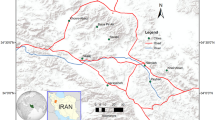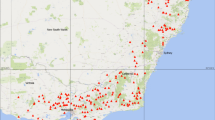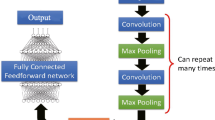Abstract
Rainfall prediction is an important issue in water resource management. Predicting rainfall helps researchers to monitor droughts, surface water and floods. The current study introduces a new deep learning model named convolutional neural network (CONN)- support vector machine (SVM)- Gaussian regression process (GPR) to predict daily and monthly rainfall data in Terengganu River Basin, Malaysia. The CONN-SVM-GRP model can extract the most important features automatically. The main advantage of the new model is to reflect the uncertainty values in the modelling process. The lagged rainfall values were used as the input variables to the models. The proposed CONN-SVM-GRP model successfully decreased the Mean Absolute Error (MAE) of other models by 5.9%-23% at the daily scale and 20%-61% at the monthly scale. The CONN-SVM-GRP model also provided the lowest uncertainty among other models, making it a reliable tool for predicting data points and intervals. Hence, it can be concluded that CONN-SVM-GRP model contributes to the sustainable management of water resources, even when satellite data is unavailable, by using lagged values to predict rainfall. Additionally, the model extracts important features without using preprocessing methods, further improving its efficiency. Overall, the CONN-SVM-GRP model can help researchers predict rainfall, which is essential for monitoring water resources and mitigating the impacts of droughts, floods, and other natural disasters.









Similar content being viewed by others
Availability of Data and Materials
Data is available from the corresponding author upon request.
References
Abbot J, Marohasy J (2014) Input selection and optimisation for monthly rainfall forecasting in queensland, australia, using artificial neural networks. Atmos Res. https://doi.org/10.1016/j.atmosres.2013.11.002
Abedinia O, Amjady N, Ghasemi A (2016) A new metaheuristic algorithm based on shark smell optimization. Complexity 21(5):97–116
Adaryani FR, Mousavi SJ, Jafari F (2022) Short-term rainfall forecasting using machine learning-based approaches of PSO-SVR, LSTM and CNN. J Hydrol 614:128463
Afshari Nia M, Panahi F, Ehteram M (2023) Convolutional neural network-ANN-E (Tanh): A new deep learning model for predicting rainfall. Water Resour Manag 1–26
Aswin S, Geetha P, Vinayakumar R (2018) Deep learning models for the prediction of rainfall. Int Conf Commun Signal Process (ICCSP). IEEE
Benmouiza K (2022) Hourly solar irradiation forecast using hybrid local gravitational clustering and group method of data handling methods. Environ Sci Pollut Res 1–19
Barrera-Animas AY, Oyedele LO, Bilal M, Akinosho TD, Delgado JMD, Akanbi LA (2022) Rainfall prediction: A comparative analysis of modern machine learning algorithms for time-series forecasting. Mach Learn Appl 7:100204
Chhetri M, Kumar S, Roy PP, Kim BG (2020) Deep BLSTM-GRU model for monthly rainfall prediction: A case study of Simtokha. Remote Sens, Bhutan. https://doi.org/10.3390/rs12193174
Das P, Sachindra DA, Chanda K (2022) Machine learning-based rainfall forecasting with multiple non-linear feature selection algorithms. Water Resour Manag 36(15):6043–6071
Ehteram M, Sammen SS, Panahi F, Sidek LM (2021) A hybrid novel SVM model for predicting CO 2 emissions using Multiobjective Seagull Optimization. Environ Sci Pollut Res 28:66171–66192
Ghanbari-Adivi E, Ehteram M, Farrokhi A, Sheikh Khozani Z (2022) Combining radial basis function neural network models and inclusive multiple models for predicting suspended sediment loads. Water Resour Manag 36(11):4313–4342
Ghimire S, Nguyen-Huy T, Prasad R, Deo RC, Casillas-Pérez D, Salcedo-Sanz S, Bhandari B (2022) Hybrid convolutional neural network-multilayer perceptron model for solar radiation prediction. Cognit Comput 1–27
Ghorbani K, Salarijazi M, Ghahreman N (2022) Developing stepwise m5 tree model to determine the influential factors on rainfall prediction and to overcome the greedy problem of its algorithm. Water Resour Manag 36(9):3327–3348
He X, Guan H, Qin J (2015) A hybrid wavelet neural network model with mutual information and particle swarm optimization for forecasting monthly rainfall. J Hydrol. https://doi.org/10.1016/j.jhydrol.2015.04.047
Hasan N, Nath NC, Rasel RI (2016) A support vector regression model for forecasting rainfall. Int Conf Electr Inf Commun Technol EICT. https://doi.org/10.1109/EICT.2015.7392014
Hu C, Wu Q, Li H, Jian S, Li N, Lou Z (2018) Deep learning with a long short-term memory networks approach for rainfall-runoff simulation. Water 10(11):1543
Jamei M, Ahmadianfar I, Olumegbon IA, Karbasi M, Asadi A (2021) On the assessment of specific heat capacity of nanofluids for solar energy applications: Application of Gaussian process regression (GPR) approach. J Energy Storage. https://doi.org/10.1016/j.est.2020.102067
Johny K, Pai ML, Adarsh S (2022) A multivariate EMD-LSTM model aided with Time Dependent Intrinsic Cross-Correlation for monthly rainfall prediction. Appl Soft Comput 123:108941
Khalili N, Khodashenas SR, Davary K, Baygi MM, Karimaldini F (2016) Prediction of rainfall using artificial neural networks for synoptic station of Mashhad: a case study. Arab J Geosci. https://doi.org/10.1007/s12517-016-2633-1
Khan MMR, Siddique MAB, Sakib S, Aziz A, Tasawar IK, Hossain Z (2020) Prediction of temperature and rainfall in bangladesh using long short term memory recurrent neural networks. Int Symp Multidiscip Stud Innov Technol (ISMSIT) (pp. 1–6). IEEE
Kim T, Yang T, Zhang L, Hong Y (2022) Near real-time hurricane rainfall forecasting using convolutional neural network models with Integrated Multi-satellitE Retrievals for GPM (IMERG) product. Atmos Res 270:106037
Kumar R, Singh MP, Roy B, Shahid AH (2021) A comparative assessment of metaheuristic optimized extreme learning machine and deep neural network in multi-step-ahead long-term rainfall prediction for all-Indian regions. Water Resour Manag 35(6):1927–1960
Mahmoodzadeh A, Nejati HR, Mohammadi M, Ibrahim HH, Khishe M, Rashidi S, Mohammed AH (2022) Developing six hybrid machine learning models based on gaussian process regression and meta-heuristic optimization algorithms for prediction of duration and cost of road tunnels construction. Tunn Undergr Space Technol 130:104759
Otchere DA, Ganat TOA, Gholami R, Ridha S (2021) Application of supervised machine learning paradigms in the prediction of petroleum reservoir properties: Comparative analysis of ANN and SVM models. J Petrol Sci Eng 200:108182
Poreh M, Mechrez E (1984) The combined effect of wind and topography on rainfall distribution. J Hydrol 72(1–2):1–23
Pham BT, Le LM, Le TT, Bui KTT, Le VM, Ly HB, Prakash I (2020) Development of advanced artificial intelligence models for daily rainfall prediction. Atmos Res. https://doi.org/10.1016/j.atmosres.2020.104845
Poornima S, Pushpalatha M (2019) Prediction of rainfall using intensified LSTM based recurrent Neural Network with Weighted Linear Units. Atmosphere. https://doi.org/10.3390/atmos10110668
Qiu M, Zhao P, Zhang K, Huang J, Shi X, Wang X, Chu W (2017) A short-term rainfall prediction model using multi-task convolutional neural networks. Proc - IEEE Int Conf Data Min ICDM. https://doi.org/10.1109/ICDM.2017.49
Ridwan WM, Sapitang M, Aziz A, Kushiar KF, Ahmed AN, El-Shafie A (2021) Rainfall forecasting model using machine learning methods: Case study Terengganu. Malaysia. Ain Shams Eng J 12(2):1651–1663
Valjarević A, Morar C, Živković J, Niemets L, Kićović D, Golijanin J, Gocić M, Bursać NM, Stričević L, Žiberna I, Bačević N, Milevski I, Durlević U, Lukić T (2021) Long term monitoring and connection between topography and cloud cover distribution in serbia. Atmosphere. https://doi.org/10.3390/atmos12080964
Van SP, Le HM, Thanh DV, Dang TD, Loc HH, Anh DT (2020) Deep learning convolutional neural network in rainfall-runoff modelling. J Hydroinf. https://doi.org/10.2166/hydro.2020.095
Vapnik VN (1998) Statistical learning theory. Wiley, New York
Xiang Y, Gou L, He L, Xia S, Wang W (2018) A SVR–ANN combined model based on ensemble EMD for rainfall prediction. Appl Soft Comput J. https://doi.org/10.1016/j.asoc.2018.09.018
Yunus RM, Hasan MM, Razak NA, Zubairi YZ, Dunn PK (2017) Modelling daily rainfall with climatological predictors: Poisson-gamma generalized linear modelling approach. Int J Climatol 37(3):1391–1399
Acknowledgements
This work was supported by the Ministry of Higher Education, Malaysia, through the Fundamental Research Grant Scheme (FRGS), under the project code of FRGS/1/2020/TK0/UNITEN/02/16. Also the authors want to thank to the Department of Irrigation and Drainage (DID) Malaysia for providing this study with the data.
Author information
Authors and Affiliations
Contributions
Mohammad Ehteram, Ali Najah Ahmed, Zohreh Sheikh Khozani, Ahmed El-Shafie contributed to the study conception and design. Ali Najah Ahmed: Data collection. Analyses: Mohammad Ehteram, Zohreh Sheikh Khozani. The manuscript was written by Mohammad Ehteram, Ali Najah Ahmed, Zohreh Sheikh Khozani, Ahmed El-Shafie.
Corresponding author
Ethics declarations
Ethical Approval
Not applicable.
Consent to Publish
The authors agree to publish in the journal.
Competing Interests
The authors state no conflict of interest.
Additional information
Publisher’s Note
Springer Nature remains neutral with regard to jurisdictional claims in published maps and institutional affiliations.
Appendix A
Appendix A
Rights and permissions
Springer Nature or its licensor (e.g. a society or other partner) holds exclusive rights to this article under a publishing agreement with the author(s) or other rightsholder(s); author self-archiving of the accepted manuscript version of this article is solely governed by the terms of such publishing agreement and applicable law.
About this article
Cite this article
Ehteram, M., Ahmed, A.N., Sheikh Khozani, Z. et al. Convolutional Neural Network -Support Vector Machine Model-Gaussian Process Regression: A New Machine Model for Predicting Monthly and Daily Rainfall. Water Resour Manage 37, 3631–3655 (2023). https://doi.org/10.1007/s11269-023-03519-8
Received:
Accepted:
Published:
Issue Date:
DOI: https://doi.org/10.1007/s11269-023-03519-8




